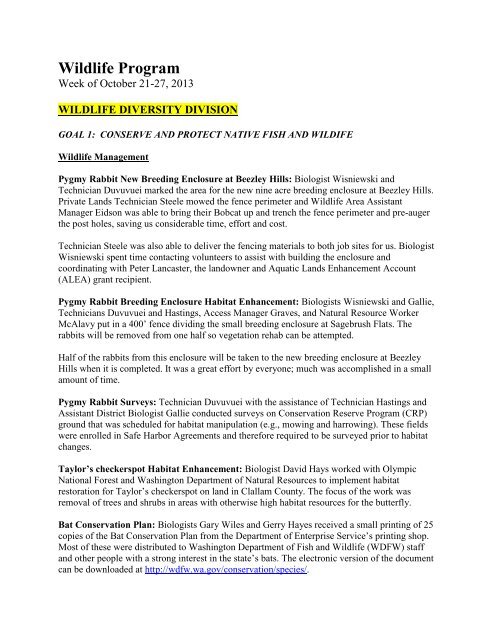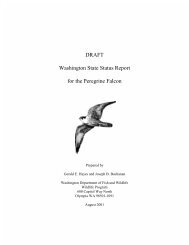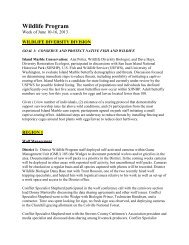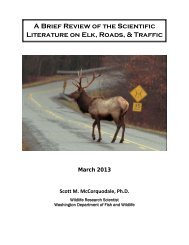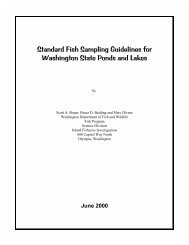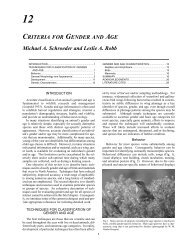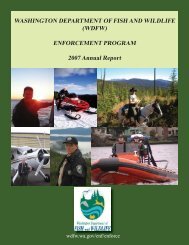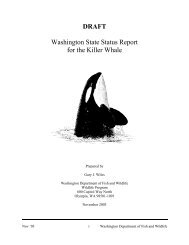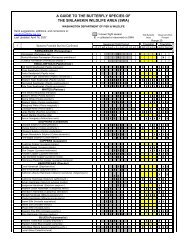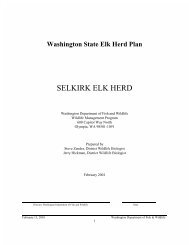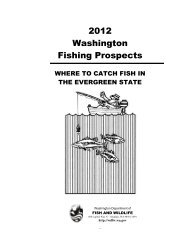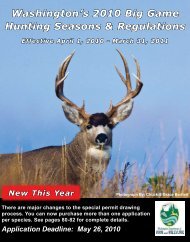October 21 - Washington Department of Fish & Wildlife
October 21 - Washington Department of Fish & Wildlife
October 21 - Washington Department of Fish & Wildlife
You also want an ePaper? Increase the reach of your titles
YUMPU automatically turns print PDFs into web optimized ePapers that Google loves.
<strong>Wildlife</strong> Program<br />
Week <strong>of</strong> <strong>October</strong> <strong>21</strong>-27, 2013<br />
WILDLIFE DIVERSITY DIVISION<br />
GOAL 1: CONSERVE AND PROTECT NATIVE FISH AND WILDIFE<br />
<strong>Wildlife</strong> Management<br />
Pygmy Rabbit New Breeding Enclosure at Beezley Hills: Biologist Wisniewski and<br />
Technician Duvuvuei marked the area for the new nine acre breeding enclosure at Beezley Hills.<br />
Private Lands Technician Steele mowed the fence perimeter and <strong>Wildlife</strong> Area Assistant<br />
Manager Eidson was able to bring their Bobcat up and trench the fence perimeter and pre-auger<br />
the post holes, saving us considerable time, effort and cost.<br />
Technician Steele was also able to deliver the fencing materials to both job sites for us. Biologist<br />
Wisniewski spent time contacting volunteers to assist with building the enclosure and<br />
coordinating with Peter Lancaster, the landowner and Aquatic Lands Enhancement Account<br />
(ALEA) grant recipient.<br />
Pygmy Rabbit Breeding Enclosure Habitat Enhancement: Biologists Wisniewski and Gallie,<br />
Technicians Duvuvuei and Hastings, Access Manager Graves, and Natural Resource Worker<br />
McAlavy put in a 400’ fence dividing the small breeding enclosure at Sagebrush Flats. The<br />
rabbits will be removed from one half so vegetation rehab can be attempted.<br />
Half <strong>of</strong> the rabbits from this enclosure will be taken to the new breeding enclosure at Beezley<br />
Hills when it is completed. It was a great effort by everyone; much was accomplished in a small<br />
amount <strong>of</strong> time.<br />
Pygmy Rabbit Surveys: Technician Duvuvuei with the assistance <strong>of</strong> Technician Hastings and<br />
Assistant District Biologist Gallie conducted surveys on Conservation Reserve Program (CRP)<br />
ground that was scheduled for habitat manipulation (e.g., mowing and harrowing). These fields<br />
were enrolled in Safe Harbor Agreements and therefore required to be surveyed prior to habitat<br />
changes.<br />
Taylor’s checkerspot Habitat Enhancement: Biologist David Hays worked with Olympic<br />
National Forest and <strong>Washington</strong> <strong>Department</strong> <strong>of</strong> Natural Resources to implement habitat<br />
restoration for Taylor’s checkerspot on land in Clallam County. The focus <strong>of</strong> the work was<br />
removal <strong>of</strong> trees and shrubs in areas with otherwise high habitat resources for the butterfly.<br />
Bat Conservation Plan: Biologists Gary Wiles and Gerry Hayes received a small printing <strong>of</strong> 25<br />
copies <strong>of</strong> the Bat Conservation Plan from the <strong>Department</strong> <strong>of</strong> Enterprise Service’s printing shop.<br />
Most <strong>of</strong> these were distributed to <strong>Washington</strong> <strong>Department</strong> <strong>of</strong> <strong>Fish</strong> and <strong>Wildlife</strong> (WDFW) staff<br />
and other people with a strong interest in the state’s bats. The electronic version <strong>of</strong> the document<br />
can be downloaded at http://wdfw.wa.gov/conservation/species/.
<strong>Wildlife</strong> Areas<br />
South Puget Sound Grassland Restoration: Biologist Regina Johnson worked with <strong>Wildlife</strong><br />
Area staff and <strong>Department</strong> <strong>of</strong> Correction prison crews at West Rocky Prairie and Scatter Creek<br />
<strong>Wildlife</strong> Area. The focus <strong>of</strong> the work was mowing Scot’s broom, herbicide application to control<br />
invasive grasses, and planting native plants in previously burned grassland habitat.<br />
REGION 1<br />
Wolf Management<br />
District 1: Specialist Shepherd investigated a shooting <strong>of</strong> dogs that appeared to be hybrids after<br />
the second attack on sheep. They had been rumored to be wolves, but were obviously not wild<br />
wolves. Samples were taken to be sent to UCLA. Specialist Shepherd participated in the<br />
fortnightly statewide wolf conference call. Specialist Shepherd participated in a conference call<br />
with Western <strong>Wildlife</strong> Outreach, Olympia and Regional staff concerning public outreach.<br />
Specialist Shepherd discussed wolves and cattle with ranchers in the Wedge and Spirit Junction<br />
areas. Specialist Shepherd discussed work duties with a contract range rider.<br />
District 3: District <strong>Wildlife</strong> Biologist Wik reported two sightings (2 weeks old) to the<br />
<strong>Department</strong> database.<br />
GOAL 1: CONSERVE AND PROTECT NATIVE FISH AND WILDIFE<br />
<strong>Wildlife</strong> Management<br />
Selkirk Woodland Caribou: District <strong>Wildlife</strong> Biologist (DWB) Dana Base received and<br />
reviewed the annual census report for Selkirk woodland caribou (DeGroot and Wakkinen 2013).<br />
The census was accomplished in the late winter (March) <strong>of</strong> 2013. Only 27 caribou were observed<br />
in three groups, all within British Columbia, but not far north <strong>of</strong> Idaho and <strong>Washington</strong>. As<br />
recently as 2009, there were 46 caribou in the census. British Columbia agency personnel are<br />
considering deploying GPS radio-collars on four or five caribou to improve monitoring <strong>of</strong> range<br />
and survival.<br />
Lincoln County Prairie Grouse<br />
Project: Biologist Atamian<br />
tracked radio marked grouse at<br />
Swanson Lakes <strong>Wildlife</strong> Area<br />
(SLWA), located four birds that<br />
had been missing for two weeks<br />
and one bird that had been<br />
missing for a month. Circled in<br />
red below is a male sage grouse<br />
roosting next to sagebrush in the<br />
interior <strong>of</strong> SLWA.
Golden Eagle Study: As part <strong>of</strong><br />
addressing lead toxicosis in golden<br />
eagles, U.S. <strong>Fish</strong> and <strong>Wildlife</strong><br />
Service (USFWS) is hoping to<br />
gain understanding <strong>of</strong> the transport<br />
<strong>of</strong> lead in ungulate gut-piles to<br />
golden eagles. In response to this<br />
concern, Assistant District<br />
<strong>Wildlife</strong> Biologist (ADWB)<br />
Annemarie Prince checked three<br />
self-activated camera stations at<br />
golden eagle nest territories for<br />
potential documentation <strong>of</strong><br />
scavenging habits by resident<br />
eagles. Other WDFW districts in<br />
eastern <strong>Washington</strong> are also<br />
participating in this project and<br />
2013 will serve as a trial run with<br />
lessons learned applied to future<br />
monitoring efforts. At the<br />
carcasses deployed at China Bend<br />
and Vulcan, golden eagles were<br />
recorded feeding on the carcass<br />
(see photos).<br />
Above: Golden Eagle at China Bend. Below: Golden<br />
Eagle at Vulcan.<br />
<strong>Wildlife</strong> Areas<br />
Sherman Creek <strong>Wildlife</strong> Area<br />
Injured Golden Eagle – <strong>Wildlife</strong><br />
Area Assistant Manager Daro<br />
Palmer checked on the immature<br />
golden eagle that has been hanging<br />
out at the Trout Lake road kill pit<br />
on the Sherman Creek <strong>Wildlife</strong><br />
Area on Tuesday. Palmer located<br />
the eagle sitting along Highway 20,<br />
so he chased it up into the brush,<br />
away from the highway. The eagle’s<br />
health had obviously deteriorated<br />
since last observed, so Palmer and<br />
Sherman Creek Hatchery Manager<br />
Mitch Combs captured the bird.<br />
Assistant <strong>Wildlife</strong> Biologist<br />
Annemarie Prince transported the<br />
eagle to the Mt. Spokane Veterinary<br />
Hospital the following day.<br />
Golden Eagle at Trout Lake
GOAL 2: PROVIDE SUSTAINABLE FISHING, HUNTING AND OTHER WILDLIFE-<br />
RELATED RECREATIONAL AND COMMERCIAL EXPERIENCES<br />
<strong>Wildlife</strong> Areas<br />
Z-Lake aeration (Swanson<br />
Lakes Area): Assistant Manager<br />
Finch and Technician Bauer<br />
cleaned <strong>of</strong>f the solar panels,<br />
reburied the compressor box<br />
(someone/something had<br />
removed the soil around it), and<br />
tested the windmill and solarpowered<br />
aeration system for the<br />
lake. The aeration system is<br />
working fine, and has been<br />
turned on for the cold season.<br />
This aeration system helps keep<br />
stocked rainbow trout alive over<br />
the winter.<br />
Bauer cleaning solar panels<br />
Z-lake with aeration working: Two hoses pumping air, shown in bottom center <strong>of</strong> photo.
WT Wooten <strong>Wildlife</strong><br />
Area – Successful Deer<br />
and Elk Hunters: Retired<br />
WDFW employee Bob<br />
Gibbons drew one <strong>of</strong> the<br />
Tucannon bull elk tags this<br />
year. His son, Sam (a<br />
current WDFW employee),<br />
accompanied him to the<br />
WT Wooten <strong>Wildlife</strong> Area<br />
for the hunt. While they<br />
were scouting for a bull elk,<br />
Sam came upon a nice<br />
mule deer buck and was<br />
able to harvest it. Bob<br />
harvested a bull elk in<br />
Cummings Creek.<br />
Retired WDFW employee<br />
Bob Gibbons displays his<br />
Tucannon bull.<br />
Bull elk taken by Bob Gibbons (retired WDFW) and mule deer buck taken by Sam Gibbons<br />
(current WDFW employee).
Private Lands/Access<br />
Pheasant Opener: Biologist Thorne<br />
Hadley rode along with Officer John for the<br />
opening <strong>of</strong> pheasant season in Southeast<br />
<strong>Washington</strong> Saturday and Sunday.<br />
Biologist Thorne Hadley encountered a few<br />
successful hunters taking advantage <strong>of</strong><br />
WDFW’s Access Program.<br />
Hunting Access Contracts: Private Lands<br />
Biologist Baarstad met with a landowner in<br />
south Lincoln County interested in WDFW<br />
hunting access programs. <strong>Wildlife</strong> Conflict<br />
Specialist Bennett issued him some permits<br />
to address deer damage on irrigated alfalfa<br />
and he chose to enroll 1,500 acres in the Hunting by Written Permission program as an option to<br />
fulfill one <strong>of</strong> the requirements <strong>of</strong> the Damage Contract.<br />
REGION 2<br />
Wolf Management<br />
Nothing to report.<br />
GOAL 1: CONSERVE AND PROTECT NATIVE FISH AND WILDIFE<br />
<strong>Wildlife</strong> Areas<br />
Prescribed Burn Team: The prescribed burn team began burning on Monday at the Chesaw<br />
Unit <strong>of</strong> the Scotch Creek <strong>Wildlife</strong> Area on the Aspen Draw Unit (24 acres). Weather and fuel<br />
conditions for the burn were ideal and all the objectives were well met. These objectives<br />
included blackening 70% <strong>of</strong> the unit (achieved 90% black), consuming litter layer to promote<br />
sunlight penetration to soil surface to promote aspen suckering, and protect a resource tree in the<br />
unit along with aspen snags.<br />
Monitoring fire effects is being conducted by Eastern <strong>Washington</strong> University (Omak) and preburn<br />
data was collected in September to determine if the aspen clone responds as expected and<br />
begins to send up new stems. Tuesday, the prescribed burn team, which included one contracted<br />
squad that day, patrolled and mopped-up the unit. Wednesday, the team continued this effort.<br />
Thursday, the team burned a black line around the Forde 2 unit. Friday, they black lined about<br />
half <strong>of</strong> the Forde 7 burn unit. The black lining consumes fuel near the fire lines thereby making<br />
actual burn day operations safer, expedient and more cost effective. Monitoring the fires at<br />
Chesaw and Sinlahekin continued to be monitored through the weekend.
Tuesday, Fuels Manager Leuschen conducted test fires on the Sherman Creek <strong>Wildlife</strong> Area and<br />
concluded objectives cannot be met this fall so burning there will resume in the spring.<br />
Left: Prescribed Burn Team Members White and Davis ignited a containment fireline on the<br />
Aspen Draw Burn at the Scotch Creek <strong>Wildlife</strong> Area, Chesaw <strong>Wildlife</strong> Unit. Right: Prescribed<br />
Burn Team Members conducted a black lining operation on the Forde 2 Burn Unit on the<br />
Sinlahekin <strong>Wildlife</strong> Area. Photos by Ray Guse.<br />
Left: Michael Dunn conducted interior ignitions during the Aspen Draw prescribed burn,<br />
Scotch Creek <strong>Wildlife</strong> Area, Chesaw Unit. Right: A mowed and wetted containment line was<br />
burned during the Aspen Draw prescribed burn, Scotch Creek <strong>Wildlife</strong> Area, Chesaw Unit.<br />
Photos by Dan Peterson.<br />
Private Lands/Access<br />
State Acres for <strong>Wildlife</strong> Enhancement (SAFE): Private Lands Biologist Braaten spent time<br />
talking to private landowners about seeding forbs and assisted other private lands biologists with<br />
marking several forb plots in Douglas County. Private Lands Biologist Braaten continues to
update CPA-6 forms for the Farm Service Agency (FSA). Private Lands Biologist Braaten<br />
contacted the Natural Resource Conservation Service (NRCS) regarding a landowner and his<br />
SAFE conservation plan. Biologist Cotton spent most <strong>of</strong> the week marking forb plots in Douglas<br />
County, also worked with seed companies to make adjustments to forb mixes due to limited<br />
availability <strong>of</strong> several forb species.<br />
Pygmy Rabbit Breeding Enclosure Habitat Enhancement: Biologists Wisniewski and Gallie,<br />
Technicians Duvuvuei and Hastings, Access Manager Graves, and Natural Resource Worker<br />
McAlavy put in a 400’ fence dividing the small breeding enclosure at Sagebrush Flats. The<br />
rabbits will be removed from one half so vegetation rehab can be attempted. Half <strong>of</strong> the rabbits<br />
from this enclosure will be taken to the new breeding enclosure at Beezley Hills when it is<br />
completed. It was a great effort by everyone; much was accomplished in a small amount <strong>of</strong> time.<br />
Pygmy Rabbit Surveys: Technician Duvuvuei with the assistance <strong>of</strong> Technician Hastings and<br />
Assistant District Biologist Gallie conducted surveys on Conservation Reserve Program (CRP)<br />
ground that was scheduled for habitat manipulation (e.g., mowing and harrowing). These fields<br />
were enrolled in Safe Harbor Agreements and therefore required to be surveyed prior to habitat<br />
changes.<br />
GOAL 2: PROVIDE SUSTAINABLE FISHING, HUNTING AND OTHER WILDLIFE-<br />
RELATED RECREATIONAL AND COMMERCIAL EXPERIENCES<br />
<strong>Wildlife</strong> Management<br />
Midwinter Waterfowl Survey – Biologists Wehland, Finger, and Duvuvuei attended a meeting<br />
with the U.S. <strong>Fish</strong> and <strong>Wildlife</strong> Service (USFWS), <strong>Washington</strong> <strong>Department</strong> <strong>of</strong> <strong>Fish</strong> and <strong>Wildlife</strong><br />
(WDFW), and Mid-Columbia Refuge Complex biologists to discuss goals, needs, and logistics<br />
<strong>of</strong> the Midwinter Waterfowl Survey. This survey is a nationwide effort to survey waterfowl in<br />
major concentration areas on their wintering grounds. Ultimately, this survey attempts to identify<br />
distribution and habitat use. The biologists discussed safety concerns with these surveys as well<br />
as how to improve overall survey design.<br />
<strong>Wildlife</strong> Areas<br />
Recreational Opportunities<br />
(Weekender) – The<br />
Winchester Regulated Access<br />
Area has hunt-able water<br />
throughout the project. Pond<br />
C is likely lower than usual,<br />
but was beginning to fill as <strong>of</strong><br />
last week.
The Frenchmen Regulated Access Area is at full capacity in most <strong>of</strong> the project. The north<br />
and east cells (6 and 7) should be 75% full for the season.<br />
GOAL 3: PROMOTE A HEALTHY ECONOMY, PROTECT COMMUNITY CHARACTER,<br />
MAINTAIN AN OVERALL HIGH QUALITY OF LIFE, AND DELIVER HIGH-QUALITY<br />
CUSTOMER SERVICE<br />
<strong>Wildlife</strong> Management<br />
Bighorn Sheep: Biologist Gallie spent time<br />
observing Swakane Bighorns during their<br />
annual rut. Focus was also paid attention to<br />
disease presence and behavior this year as a<br />
there were several documented wandering<br />
bighorns this year in and around domestic<br />
grazing areas. Sheep were observed in<br />
normal activity and on all occasion after<br />
running, none were observed to show any<br />
pneumonic signs. Occasional observations<br />
will be kept up in the coming months.<br />
While not the entire herd, 88 sheep were<br />
counted (about ¾ the herd) with 39 rams.<br />
Most impressive were that 27 <strong>of</strong> these<br />
sheep were ¾ curl or greater (see photos).<br />
Swakane rams jostling for dominance –<br />
Photo by J. Gallie.
<strong>Wildlife</strong> Areas<br />
Bluebird Nest Box<br />
Building at Tonasket<br />
Middle School – Manager<br />
Haug visited the Tonasket<br />
Middle School and<br />
facilitated a bluebird nesting<br />
box building event as part <strong>of</strong><br />
a sixth grade science course<br />
(see photo). All students did<br />
a great job in completing<br />
their boxes and they will<br />
have the opportunity to<br />
deploy each <strong>of</strong> them on the<br />
Sinlahekin <strong>Wildlife</strong> Area<br />
during a future (yet to be<br />
determined) field trip this<br />
fall.<br />
Ecology <strong>of</strong> the Okanogan – Okanogan High School Field Trip: Assistant manager Haug<br />
escorted a small science class from Okanogan High School out to Driscoll Island to discuss<br />
management <strong>of</strong> the island, salmon recovery projects and history <strong>of</strong> the wildlife area (see photo).<br />
The class, titled Ecology <strong>of</strong> the Okanogan, focuses on the human impact in the Okanogan Valley<br />
as it relates to<br />
agricultural<br />
production, natural<br />
resource extraction<br />
and protection. The<br />
group, which<br />
included Kristen<br />
Cook from the<br />
Okanogan<br />
Conservation District<br />
and Sean Koester<br />
from Cascade<br />
Columbia <strong>Fish</strong>eries<br />
Enhancement Group,<br />
discussed chiefly<br />
salmon issues, life<br />
history, and how we<br />
as managers are<br />
trying to increase<br />
their numbers. They got to see spawned salmon along the banks <strong>of</strong> the Similkameen River and<br />
one student found a spawned salmon with a radio transmitter in its mouth. She was pretty<br />
excited, but even more thrilled when she learned she’ll receive a $25 reward.
Above: Sinlahekin fall colors –<br />
Photo by J. Heinlen.<br />
Left: Sinlahekin Creek surrounded<br />
by Cottonwood leaves, Sinlahekin<br />
<strong>Wildlife</strong> Area – Photo by Justin<br />
Haug.
REGION 3<br />
GOAL 1: CONSERVE AND PROTECT NATIVE FISH AND WILDIFE<br />
<strong>Wildlife</strong> Management<br />
Burrowing Owls: A burrowing<br />
owl that was marked near Pasco<br />
with a solar powered GPS<br />
platform transmitter terminal<br />
(PTT) last June is on the move!<br />
After spending the summer<br />
north <strong>of</strong> the Tri-Cities, she<br />
traveled approximately 1,000<br />
miles south in about seven days<br />
and landed at the Channel<br />
Islands National Park in<br />
California. A neighboring owl<br />
marked on the Arid Lands<br />
Ecology (ALE) Reserve has<br />
moved to northeast California.<br />
These detailed data will provide<br />
valuable information on owl<br />
ecology and conservation.<br />
Pheasant Release<br />
Program: Private Lands<br />
Biologist Stutzman and<br />
Technician Kaelber<br />
released pheasants in<br />
Franklin County on Friday.<br />
Big Flat, Lost Island<br />
(Army Corps <strong>of</strong> Engineers)<br />
and Hope Valley (WDFW)<br />
received a total <strong>of</strong> 360<br />
roosters during the second<br />
<strong>of</strong> four total releases this<br />
season. The hunting parties<br />
using one <strong>of</strong> the sites were<br />
thrilled to see a trailer full<br />
<strong>of</strong> naive roosters.<br />
Access Technician<br />
Kaelber sets a few roosters<br />
loose at Big Flat Habitat<br />
Management Unit.<br />
View <strong>of</strong> a burrowing owl’s migration from Pasco to the<br />
Channel Islands in California.
REGION 4<br />
GOAL 1: CONSERVE AND PROTECT NATIVE FISH AND WILDIFE<br />
<strong>Wildlife</strong> Management<br />
North Cascades Elk Working Group: Biologist DeBruyn facilitated meeting <strong>of</strong> the public<br />
safety committee <strong>of</strong> The North Cascades Elk Work Group. Among those in attendance were<br />
representatives <strong>of</strong> <strong>Washington</strong> State <strong>Department</strong> <strong>of</strong> Transportation (WSDOT), <strong>Washington</strong> State<br />
Patrol (WSP), WDFW, Western <strong>Washington</strong> University (WWU), two tribes and landowners<br />
from the Skagit Valley. Topics discussed included our contribution to the herd plan, data<br />
gathering related to elk/vehicle collisions and elk crossings on Highway 20, impending erection<br />
<strong>of</strong> warning signs, new technology for preventing collisions, new detection methods and eventual<br />
solutions to elk highway crossing issues. DeBruyn also took down motion activated cameras that<br />
had been monitoring elk crossing activity along Highway 20 as they are needed for another<br />
project.<br />
North Cascades Elk Management <strong>Wildlife</strong> Program Updates: Biologist Danilson facilitated a<br />
meeting <strong>of</strong> the monitoring and research committee <strong>of</strong> the North Cascades Elk Work Group.<br />
Committee turnout was low; however, substantial progress was made in developing potential<br />
methods for conducting ground-based surveys <strong>of</strong> elk in agricultural areas and areas outside <strong>of</strong> the<br />
existing aerial survey counting units. This addresses one <strong>of</strong> the objectives in the draft elk<br />
management plan and also one <strong>of</strong> the criticisms that some residents have about annual population<br />
estimates underrepresenting elk in these areas.<br />
Peregrine Falcon<br />
Management: Biologist<br />
DeBruyn accompanied a<br />
biologist and an engineer from<br />
Puget Sound Energy to visit a<br />
peregrine nest site at Deception<br />
Pass that is surrounded by<br />
Puget Sound Energy right <strong>of</strong><br />
ways and powerlines.<br />
Vegetation management is<br />
planned and a plan was<br />
formulated to minimize<br />
disturbance to the birds.<br />
Male Peregrine Falcon at<br />
Deception Pass State Park<br />
Woodland Park Zoo (WPZ) “Avoiding Urban <strong>Wildlife</strong> Conflict” lecture: Biologist<br />
Anderson gave a presentation to the WPZ fall Backyard Habitat class regarding how to live with<br />
urban wildlife, not create a situation that may result in pest individual(s), urban ecology <strong>of</strong><br />
common wildlife known for this occasional pesky behavior, and what is best biologically and
legally to remedy a nuisance situation. General information on this topic can be found at the<br />
WDFW Living with <strong>Wildlife</strong> website at http://wdfw.wa.gov/living/species/.<br />
Mountains to Sound Greenway Technical Advisory Committee Annual Meeting: Biologist<br />
Anderson represented WDFW at the annual Mountains to Sound Greenway Technical Advisory<br />
Committee Annual Meeting. The meeting discussed the Teanaway Community Forest<br />
acquisition with the collaboration <strong>of</strong> many collaborating non-pr<strong>of</strong>it, public and private entities<br />
and development <strong>of</strong> a management regime for the property to provide for ecosystem function<br />
while affording human recreation. The site will be jointly managed by WA DNR and WDFW for<br />
fish, wildlife and recreation. More information can be found<br />
here: http://wdfw.wa.gov/news/sep3013b/<br />
http://www.forterra.org/blog/teanaway_conservation_funded_in_capital_budget<br />
The efforts <strong>of</strong> the Greenway to establish the Mountains to Sound Greenway area, which stretches<br />
along the I-90 corridor from Seattle to Ellensburg, as a “National Heritage Area” was also<br />
discussed and status <strong>of</strong> progress with efforts. More information can be found<br />
here: http://mtsgreenway.org/heritage. Future smaller-scale planning efforts for wildlife and<br />
recreation within the Greenway will involve the Snoqualmie Valley area.<br />
Osprey and Bald Eagle Management: Biologist Anderson returned multiple requests for<br />
direction and process regarding take authorization <strong>of</strong> osprey nests on cell towers and other<br />
structures. Biologist Anderson continues to provide direction to those inquiring about eagle<br />
management in King County.<br />
Great Blue Heron Management: Biologist Anderson met with National Parks Service (NPS),<br />
U.S. Army Corp <strong>of</strong> Engineers (USACE), Heron Habitat Helpers, City <strong>of</strong> Seattle Parks and other<br />
collaborators regarding a grant study that is examining how to better provide urban wildlife<br />
outreach, in particular regarding local nesting herons, in the Magnolia and Ballard area. Viewing<br />
and outreach station feasibility, costs, interest, etc. are being examined for the USACE Ballard<br />
Locks as well as city <strong>of</strong> Seattle’s Discovery Park Learning Center. Assistant District Biologist<br />
Cyra continued to correspond in regards to concern over snag management along SR203 near a<br />
small Great Blue Heron colony.<br />
<strong>Wildlife</strong> Areas<br />
Leque Island Alternatives Analysis and Design Project: Projects Coordinator Brokaw and<br />
Skagit <strong>Wildlife</strong> Area Manager Rotton prepared presentations for the upcoming Leque Island<br />
public meeting on <strong>October</strong> 30 at Stanwood Middle School from 6:30 to 8:00 p.m. Also, the<br />
Leque Island cross-program district review team met to coordinate details on the upcoming<br />
Leque Island public meeting. More information on the meeting can be found<br />
at http://wdfw.wa.gov/news/oct1413b/.<br />
Ebey Island Unit: Snoqualmie <strong>Wildlife</strong> Area Manager Brian Boehm worked with two<br />
volunteers to build and install sign kiosks at the middle and Ebey Slough parking areas. A<br />
pedestrian gate was also installed at the middle parking area. Additionally, Manager Boehm<br />
worked with the grazing lessee to round up five renegade cows that avoided capture earlier this
month. Manager Boehm also met with WDFW staff Link and Hennick to discuss plans for Ebey<br />
Island Unit that meet requirements detailed in the Coastal Protection Fund proposal.<br />
Lake Terrell Dam Water Flows: Manager Kessler monitored the water level at the Lake Terrell<br />
dam on Terrell Creek. A beaver dam on the creek that was blocking water flows was removed.<br />
GOAL 2: PROVIDE SUSTAINABLE FISHING, HUNTING AND OTHER WILDLIFE-<br />
RELATED RECREATIONAL AND COMMERCIAL EXPERIENCES<br />
<strong>Wildlife</strong> Management<br />
Cackling Goose survey: Biologist DeBruyn surveyed areas in Whatcom and Skagit counties for<br />
Cackling Canada Geese as part <strong>of</strong> an interstate effort to detect these diminutive honkers. These<br />
geese are being collared as part <strong>of</strong> a management strategy and part <strong>of</strong> the survey is searching for<br />
collared geese. This year’s survey was truncated due to foggy conditions and only areas that have<br />
yielded sightings in the past were checked. A total <strong>of</strong> 83 cacklers were observed, but no collars<br />
were seen this year. All sightings were associated with large flocks <strong>of</strong> lesser snow geese.<br />
Elk Incentive Permits – Western <strong>Washington</strong>: Biologist Anderson was notified by a hunter<br />
that received one <strong>of</strong> the WWA elk incentive permits. Anderson answered questions, gave advice<br />
on where elk are in District 12, hunting considerations for various areas, and suggestions for<br />
other Districts that are near where this person lives. District 12 and District 11 staff will continue<br />
to work with this hunter to find a nice opportunity for, in this case, a youth hunter. More on the<br />
incentive permit program can be found at https://fishhunt.dfw.wa.gov/wdfw/special_hunt.html.<br />
Vashon Island Center Forest Hunt: Biologist Anderson kept in touch with King County staff<br />
regarding updates on the progress <strong>of</strong> the Island Center Forest hunt that is open currently on<br />
Vashon Island. Hunters are successfully getting animals out there, with one happy hunter<br />
reporting harvest <strong>of</strong> a buck and a doe using their second tag. More on this soon to close annual<br />
hunt is available at http://kingcountyparks.wordpress.com/2013/10/10/park-alert-limited-deerhunting-opens-oct-12-at-island-center-forest/.<br />
Pigeon Guillemot Population Survey Report: Assistant District Biologist Cyra resurrected<br />
notes and data and continued work on finalizing the report <strong>of</strong> the breeding survey <strong>of</strong> Pigeon<br />
Guillemots in Puget Sound.<br />
<strong>Wildlife</strong> Areas<br />
Pheasant Release program: Pheasant release volunteers encountered a locked gate on the Bow<br />
Hill Road release site. Enforcement has been notified and will increase patrol <strong>of</strong> the area. Skagit<br />
<strong>Wildlife</strong> Area staff repaired pheasant pens. Additional materials for repair were requested and<br />
provided by the Game Farm. Snoqualmie <strong>Wildlife</strong> Area Manager Brian Boehm continued<br />
maintenance on the pheasant net pen facility. Lighting was added to the loading area for safety<br />
and to attract the birds into the loading area. Whatcom <strong>Wildlife</strong> Area Manager Kessler received<br />
390 pheasants for the pheasant releases. Birds were released by volunteers on the Intalco, Lake<br />
Terrell and British Petroleum (BP) units. Snoqualmie <strong>Wildlife</strong> Area Manager Brian Boehm
continues to monitor mortality <strong>of</strong> pheasants while in the net pen facility. Last week there were<br />
zero dead birds and only two escapees. Pheasant release volunteers are informed <strong>of</strong> weekly<br />
results and encouraged to keep up the good work.<br />
British Petroleum (BP) Hunting Access: Manager Kessler posted signs and managed a partial<br />
closure <strong>of</strong> the hunting area at the British Petroleum unit. BP workers performed environmental<br />
monitoring <strong>of</strong> vegetation survival in wetland enhancement areas.<br />
Hunting Season Prep: Natural<br />
Resources Specialist Greg Meis<br />
and Natural Resources Tech<br />
Curran Cosgrove checked the<br />
North Fork Access Boundary<br />
signs. There have been some<br />
questions about posting this dike<br />
closed to hunting. A meeting will<br />
be scheduled to discuss this and<br />
other potential access issues for<br />
this hunting season. Natural<br />
Resources Tech Cosgrove updated<br />
safety zone signs and game<br />
reserve signs on DeBay’s Slough<br />
Reserve and Hunt Unit. Cosgrove<br />
mowed the <strong>Washington</strong> <strong>Wildlife</strong><br />
and Recreation Program planting area. The North Sound Weed Crew performed additional<br />
marking and weed control on the restoration planting area.<br />
Manager Rotton received a call from a hunter on Leque Island on Friday afternoon regarding the<br />
notice <strong>of</strong> closure to hunting on November 4. The hunter was assured the posting was not accurate<br />
and no closure was expected for the site. Staff investigated and took down the sign. Enforcement<br />
reported a similar sign posted on the Samish Unit this weekend. Other hunt unit signs will be<br />
checked early this week.<br />
Private Lands/Access<br />
Private Lands Access Contracts: Biologist Milner continued work on Waterfowl and Snow<br />
Goose Quality Hunt contracts. Tech Otto continued with landowner meetings and to sign<br />
contracts for 2013/14 season. Otto was able to meet with four landowners, all <strong>of</strong> which were<br />
happy to partner again with WDFW.<br />
Blind Construction and Unit Set-up: Techs Deyo and Otto continued with waterfowl unit setups<br />
in Whatcom, Skagit and Snohomish counties. This entailed setting up unit boundaries,<br />
building blinds and brushing them to the terrain, installing parking signs and preparing parking<br />
areas.
GOAL 3: PROMOTE A HEALTHY ECONOMY, PROTECT COMMUNITY CHARACTER,<br />
MAINTAIN AN OVERALL HIGH QUALITY OF LIFE, AND DELIVER HIGH-QUALITY<br />
CUSTOMER SERVICE<br />
<strong>Wildlife</strong> Management<br />
Skagit County Elk Conflict: Conflict Specialist Griffith worked with eight landowners this<br />
week on elk damage issues. All eight landowners are experiencing elk coming into grass hay<br />
fields as well as causing fence damages. In response, Griffith issued out seven damage permits<br />
and provided technical guidance on hazing techniques.<br />
In addition to new damage complaints and follow-up on existing complaints, Griffith and<br />
Danilson spent the majority <strong>of</strong> this week working on elk damage issues in the Day Creek area.<br />
Whatcom and Skagit County Deer Conflict: Conflict Specialist Griffith received a call from a<br />
resident in Lynden regarding deer coming into his strawberries. Griffith will conduct a site visit<br />
over the weekend or early next week. Biologist Danilson followed up with a resident <strong>of</strong><br />
Anacortes to discuss deer problems and potential solutions to his particular issues.<br />
<strong>Washington</strong> State <strong>Department</strong> <strong>of</strong> Labor and Industries Explosives Inspection: Biologist<br />
Danilson attempted to follow-up with the local Labor and Industries explosives inspector<br />
regarding an inspection <strong>of</strong> storage facilities to determine whether WDFW is in compliance.<br />
Danilson also communicated with internal staff to evaluate the potential for future explosives<br />
storage in Region 4.<br />
<strong>Wildlife</strong> Areas<br />
Skagit <strong>Wildlife</strong> Area Signage: Staff created and posted wildlife area maps for Headquarters,<br />
Samish, Leque Island, Debay’s Slough, and North Fork Access kiosks. This signs include safety<br />
zone areas. Staff posted game reserve signs at the Snow Goose Reserve in the Northeast side <strong>of</strong><br />
reserve. Manager Rotton has been coordinating with the Skagitonians to Preserve Farmland on a<br />
Talking Fields sign that will be installed the end <strong>of</strong> <strong>October</strong>.<br />
Samish River Unit: Manager Rotton received the drawing for culvert crossing from the CAMP<br />
program. This should complete the design drawings for the permit package. Loren Brokaw has<br />
submitted the project for the SEPA review process. Staff placed the water control boards in north<br />
ditch riser at the Samish Unit. The share-crop farmer was able to harvest potatoes. The safety<br />
zone signs were adjusted following the harvest.<br />
Private Lands/Access<br />
Hunting Opportunity Inquiry: Tech Otto fielded many calls for waterfowl hunters with<br />
questions about the Waterfowl Quality program. Otto also coordinated volunteers to assist with<br />
setting up Waterfowl Quality Hunt units while staff is shorthanded.
GOAL 4: BUILD AN EFFECTIVE AND EFFICIENT ORGANIZATION BY<br />
SUPPORTING OUR WORKFORCE, IMPROVING BUSINESS PROCESSES, AND<br />
INVESTING IN TECHNOLOGY<br />
<strong>Wildlife</strong> Management<br />
Volunteers: Snoqualmie <strong>Wildlife</strong> Area Manager Brian Boehm distributed a task list and request<br />
for local volunteers to assist with field work that is needed to be completed for this coming<br />
hunting season. Through numerous Citizen Advisory Group meetings targeting specific user<br />
groups, Manager Boehm has utilized volunteers this past week for pheasant pen repairs, building<br />
and installing sign kiosks and entrance gates, and for collecting hunter comments.<br />
Radio Training: Assistant District Biologist Cyra continued to provide assistance to staff with<br />
instruction on radio training, radio use requirements, and assigning radio call numbers.<br />
Aircraft Safety: Assistant District Biologist Cyra provided follow-up documentation on the<br />
proposed Aircraft Standard Operating Procedure to the safety <strong>of</strong>fice.<br />
Dave Brittell’s Retirement: Assistant District Biologist Cyra along with several other current<br />
and former Region 4 staff attended the retirement celebration for Dave Brittell, former <strong>Wildlife</strong><br />
Program Assistant Director. Dave led the program for many years and was instrumental in<br />
setting in place a program to conserve nearly 300,000 acres <strong>of</strong> wildlife habitat among many other<br />
accomplishments.<br />
Private Lands Hiring: Biologist Milner conducted the second round <strong>of</strong> interviews for the new<br />
Private Lands biologist and talked to those references that could be reached. Reference checks<br />
will continue this week and we plan to <strong>of</strong>fer the position this week.<br />
Natural Resource Technician Hiring: Conflict Specialist Griffith contacted applicants this<br />
week. Biologist Danilson reviewed and finalized the work plan for this position. Interviews for<br />
both positions will take place during the week <strong>of</strong> <strong>October</strong> 28. Biologist Danilson also reviewed<br />
applicants for the seasonal swan technician position, contacted applicants to be interviewed and<br />
arranged for internal staff to be interview panelists.<br />
REGION 5<br />
GOAL 1: CONSERVE AND PROTECT NATIVE FISH AND WILDIFE<br />
<strong>Wildlife</strong> Management<br />
Cackling Canada Goose Surveys: In cooperation with U.S. <strong>Fish</strong> and <strong>Wildlife</strong> Service<br />
(USFWS), Oregon <strong>Department</strong> <strong>of</strong> <strong>Fish</strong> and <strong>Wildlife</strong>, California <strong>Department</strong> <strong>of</strong> <strong>Fish</strong> and Game,<br />
as well as British Columbia and Region 5 wildlife biologists conducted surveys for cackling<br />
Canada geese. The survey involves locating flocks <strong>of</strong> cacklers and examining the birds for neck<br />
collars. Cackling Canada geese were captured and marked on their breeding grounds in western
Alaska’s Yukon/Kuskokwim National <strong>Wildlife</strong> Refuge during the summer <strong>of</strong> 2011, 2012 and<br />
2013. The survey protocol involves two repetitions <strong>of</strong> the effort and will generate a mark/re-sight<br />
estimate for the total population <strong>of</strong> cackling Canada geese.<br />
WDFW staff including Biologists Miller, Bergh, George, and Holman contributed a total <strong>of</strong><br />
approximately 26,000 geese to the overall survey effort. Thirty-seven marked birds were noted<br />
among these individuals and many <strong>of</strong> the collar characters were observable. Most <strong>of</strong> the geese<br />
were located in Clark County. Population estimates generated from past year’s efforts have<br />
resulted in a total <strong>of</strong> approximately 250,000 cackling Canada geese. Please see the attached<br />
photos <strong>of</strong> cacklers on their wintering habitat in Southwest <strong>Washington</strong>.<br />
The small Canada geese are <strong>of</strong> particular management concern because they are used extensively<br />
for subsistence by the native peoples <strong>of</strong> western Alaska, provide recreational hunting in<br />
<strong>Washington</strong>, Oregon, and California, but also cause extensive damage to agricultural crops. For<br />
more information on the Alaskan breeding grounds <strong>of</strong> the cacklers visit the USFWS website<br />
at http://www.fws.gov/alaska/nwr/yukondelta/index.htm.<br />
Region 5 Cackling Canada Goose Surveys<br />
Western Pond Turtle: Biologist Anderson conducted a follow-up site visit to monitor the recent<br />
mowing that took place at Bergen Road western pond turtle site. Approximately 10 acres <strong>of</strong>
upland nesting habitat for western pond turtles was mowed to control Scot's broom and<br />
blackberry. This ongoing treatment, in cooperation with the U.S. Forest Service (USFS) and the<br />
Skamania County Noxious Weed Program, has been very successful at maintaining quality<br />
upland wildlife habitat. The recent warm and dry weather provided favorable conditions for a fall<br />
treatment. The weather has been so favorable even the turtles have been basking in the mid-day<br />
heat.<br />
Western Pond Turtle Habitat<br />
<strong>Wildlife</strong> Areas<br />
Shillapoo <strong>Wildlife</strong> Area -- Watchable <strong>Wildlife</strong>: Many fall migrants have completed their<br />
journey from the north. Thousands <strong>of</strong> Canada geese and sandhill cranes have arrived at Shillapoo<br />
<strong>Wildlife</strong> Area and the surrounding lands to spend the winter. The geese and cranes can easily be<br />
viewed at several sites in the northern and southern units <strong>of</strong> the <strong>Wildlife</strong> Area. Additional<br />
waterfowl such as greater white-fronted geese, cackling geese, snow geese, various ducks and<br />
many other fall migrants are also beginning to be seen at Shillapoo as well. Rough-legged<br />
hawks, a peregrine falcon, a short-eared owl, bald eagles, and American pipits have been spotted<br />
at the <strong>Wildlife</strong> Area over the last two weeks. The peregrine falcon was seen feeding on a small<br />
goose, likely a cackling goose, in the north unit <strong>of</strong> the <strong>Wildlife</strong> Area.<br />
Canada Geese<br />
Sandhill Cranes
GOAL 2: PROVIDE SUSTAINABLE FISHING, HUNTING AND OTHER WILDLIFE-<br />
RELATED RECREATIONAL AND COMMERCIAL EXPERIENCES<br />
Private Lands/Access<br />
St. Helens Land Access Volunteer Orientation: Biologist Stephens and Technician Sample<br />
conducted a mandatory orientation session for those interested in participating in the St. Helens<br />
Land Access Program. In addition, Biologist Miller, with assistance from Technician Sample,<br />
conducted radio training for the St. Helens Land Access Program volunteers. By contract with<br />
<strong>Department</strong> <strong>of</strong> Natural Resources (DNR), all users <strong>of</strong> their frequencies must receive training and<br />
be assigned a radio call number to use radios to communicate on DNR frequency.<br />
GOAL 3: PROMOTE A HEALTHY ECONOMY, PROTECT COMMUNITY CHARACTER,<br />
MAINTAIN AN OVERALL HIGH QUALITY OF LIFE, AND DELIVER HIGH-QUALITY<br />
CUSTOMER SERVICE<br />
<strong>Wildlife</strong> Management<br />
Ho<strong>of</strong> Disease Public Working Group: The prevalence and geographic scope <strong>of</strong> ho<strong>of</strong> disease in<br />
elk in Southwest <strong>Washington</strong> has increased significantly. Understanding this issue is a priority<br />
and WDFW is committed to the sound management <strong>of</strong> these important resources. Understanding<br />
which type <strong>of</strong> ho<strong>of</strong> disease in elk is present and what the possible cause is will provide a better<br />
understanding <strong>of</strong> how it is occurring. WDFW biological and veterinary staff have been working<br />
with veterinary experts throughout the country, and abroad, to develop sampling and testing<br />
plans for identifying the cause <strong>of</strong> ho<strong>of</strong> disease in southwest <strong>Washington</strong> elk to better understand<br />
the causes and effects <strong>of</strong> the ho<strong>of</strong> disease phenomenon seen in western <strong>Washington</strong> elk herds.<br />
We are expectant that this effort will provide further information and insight to the issue <strong>of</strong> ho<strong>of</strong><br />
disease in Southwest <strong>Washington</strong> and guide future management efforts.<br />
WDFW established a Public Working Group as we believe it is important to work together as we<br />
try to better understand and address this issue. The purpose <strong>of</strong> this Working Group is to provide<br />
the opportunity to share information about the ho<strong>of</strong> disease phenomenon, discuss research and<br />
management questions with regard to ho<strong>of</strong> disease, and public outreach. The first Working<br />
Group meeting was held this past week. Topics covered included an overview <strong>of</strong> management<br />
and disease history <strong>of</strong> elk in Southwest <strong>Washington</strong>, an overview <strong>of</strong> WDFW ho<strong>of</strong> disease<br />
investigations and findings to date, an introduction <strong>of</strong> a management discussion, as well as an<br />
opportunity for public testimony. We are very appreciative <strong>of</strong> all the Working Group members<br />
and their time and commitment to work with us on this disease situation in Southwest<br />
<strong>Washington</strong>.<br />
REGION 6<br />
None.


